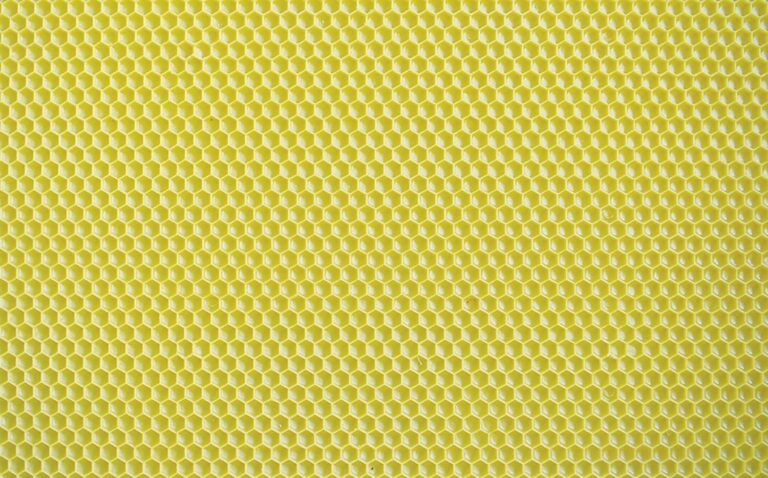Foundation has different sizes of cells and cells per sheet and with the confusion that already surrounds beekeeping, marketing claims on foundation make it that much harder. Small cell comb, natural comb, large cell and cell count are all terms you commonly hear.
When we talk about the cell count, we are actually talking about the number of imprinted hexagons that already come on the foundation directly from the supplier. Foundation manufacturers make foundations in many different ways, and some are better than others.
Some companies like Mann Lake, Acorn, and Pierco make their plastic foundation using an injection mold machine. Others, like Premier / Pura use a pressed plastic design that is similar to how pure wax foundation is made.
Table of Contents
Plastic And Wax Bee Foundation Sizes
Most beekeepers use beeswax-coated plastic foundation or 100% wax foundation in the frames to give support to the comb and to encourage bees to build their comb straight.
However, honey bees can build their comb perfectly fine without foundation in a foundationless frame, but possibly to the disapproval of their beekeeper.
In our own hives, we use foundationless frames as well as our black plastic foundation. Our plastic foundation is coated with twice as much beeswax as the standard plastic foundation, and our cell sizes are smaller than most other sheets of foundation on the market.
Below we share more about our foundation and others available on the market.
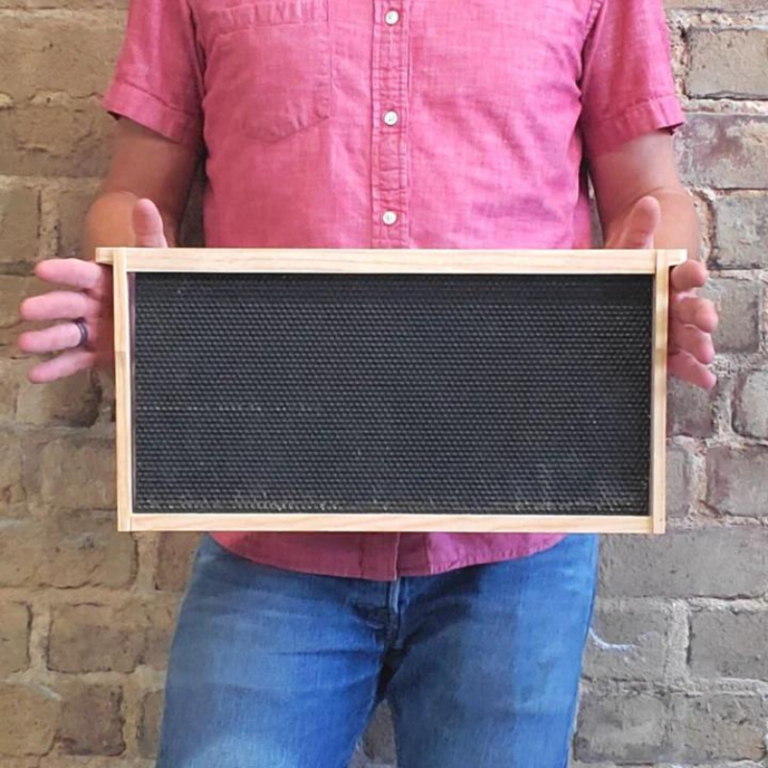
Beeswax used on Wax and Plastic Foundation
The beeswax that is when making foundation is typically beeswax. US producers of foundation use pure beeswax, but it is common for Chinese beekeeping equipment manufacturers to claim pure beeswax, but actually blend it with paraffin our other waxes. There is not anyone regulating this and it is a common practice. This is why we recommend buying only American beekeeping supplies.
Beeswax Used in Wax Foundation
The wax that is used in pure beeswax foundation sheets is commonly made by either Mann Lake or Dadant. These companies have made wax foundation for a long time, especially Dadant. It is very common for beekeepers of all sizes to sell their wax blocks or capping to these companies where they will re-melt it and turn it into foundation. They will grade the wax based on the source and how well the wax was filtered and pay the beekeepers for their wax or provide a store credit.
When buying the wax sheets, this wax is a blend of wax from beekeepers all across the US and is likely to be holding miticides in the wax from previous mite treatments. It is hard to avoid this when buying foundation, but it should be known this is a downside of buying wax foundaiton.
Beeswax Used In Wax Coated Plastic Foundation
Beeswax is a really great addition to plastic foundation. So much so that we use a double coating of beeswax on our foundation. This wax is added to the plastic after the plastic has been molded and is actually sprayed onto the plastic, rather than being dipped.
When waxing your own foundation at home, it is common to roll it on with a foam roller.
The companies that make the plastic foundation will buy their wax in 20-50 pound clean blocks. These blocks are then melted down and sprayed onto the foundation in liquid form.
The most common source of clean wax for this use is from a company called A.H. Meyers and Sons which has a great reputation for creating high quality beeswax.
Measuring Cell Sizes

When we talk about cell size, we are talking about the average width of the space where the bees will raise each individual honey bee.
A smaller cell size will create a slightly smaller honey bee than a larger one. The size of worker bees are dictated by the size of the cell they comb out of. Also smaller cells will also allow more cells per foundation.
We use and sell Acorn Plastic Foundation because of the quality of their wax, manufacturing excellence, and the foundation’s size. We have found their foundation to be the best option when trying to blend the bee’s needs and the beekeeper’s needs.
The traditional way is to take a group of 10+ cells on the sheet and measure the distance from the edge of one cell to the inside edge of a cell on the same row.
If you measure 20 cells and get a distance of 105 millimeters. You would divide 105 by 20 to get an average cell size of 5.25 mm. This includes both the cell size and the cell wall.
This measurement is the widely accepted way of measuring cells, though not the most accurate. The cell wall is very thin among all manufacturers, and trying to remove the cell wall from the measurement provides a number that is difficult to compare to other foundations. And the cell wall measurement is not consistent in nature anyway; read more on that below.
Another way of measuring cell size is by measuring the number of cells in a square inch or a rhombus and dividing by the number of cells. There is a point where you can go too far in getting the most accurate number, but to what end? As soon as the bees start using the comb, the number will change.
Naturally, with the wild comb, plastic foundation, or wax foundation, the thickness of the cell wall and cell size will change over time. This is a result of bees naturally making their cells different sizes.
Also, as bees raise each generation of bees, the thickness of the cell wall increases as each bee leaves behind a cocoon in the cell that isn’t removed before the next egg is laid. And a queen can use the same cells to raise their bees in for 5 years or more, with each cell producing 50-plus cells in that time.
For cells that the honey bees are going to use solely for storing honey, as in honey boxes, it is actually better to have very large cells instead of small cells. The larger the width of the cell, the fewer cell walls and the more honey that can fit on a frame.
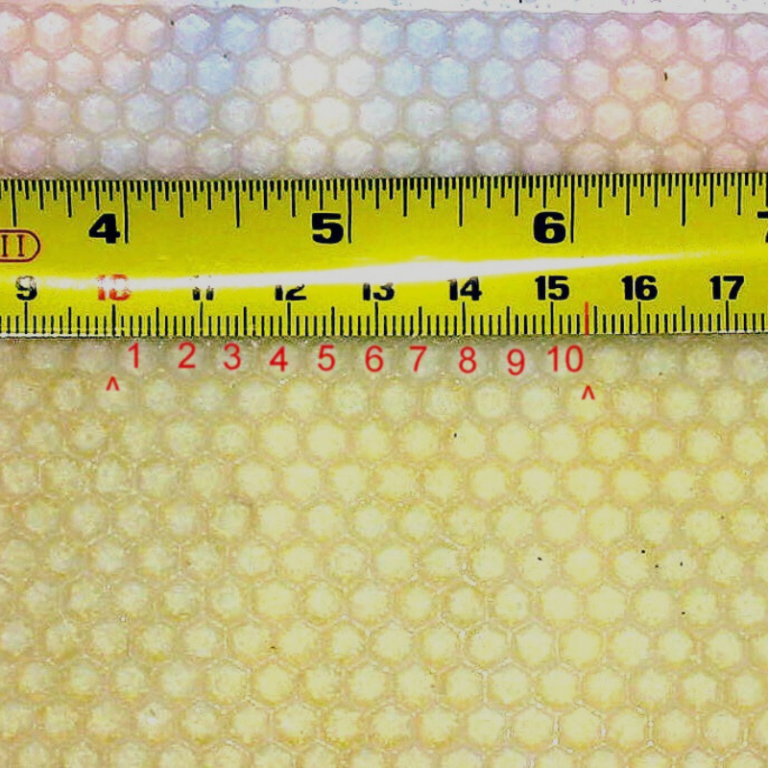
This is true, but beekeepers don’t pursue this because the perceived benefit is negligible. There are other, more effective ways to maximize honey in a frame.
If beekeepers wanted to do this, they would use drone comb frames in all their honey boxes.
Understanding Cell Size On Bee Foundation
Small Cell Foundation
Cells per sheet will vary from one manufacturer to the other, even on the same size sheet of foundation, which is roughly 16.75 x 8.375-inches for deep foundation or 16.75 x 5.5-inches for medium foundation.
This is because the width of the cell, the thickness of the cell wall, and the design of the foundation all change the count.
For our measurements below, we counted the fully developed cells on the sheet. However, because of some foundation designs, not all the cells are actually usable by the bees because they are covered by wood.
So while the cell count may be higher and the marketing claims that go with it inflated, the usable cells are lower than other manufacturers.
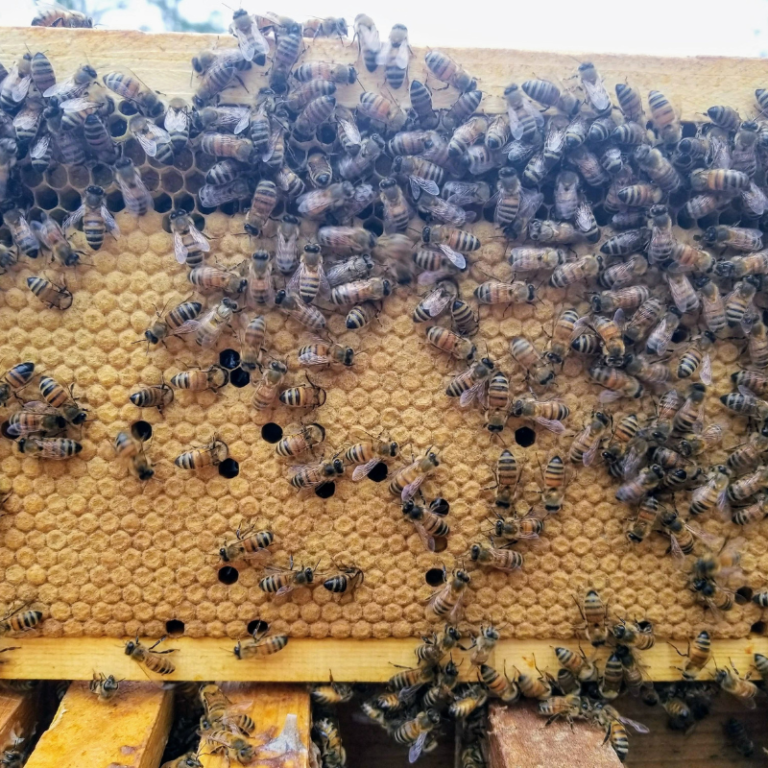
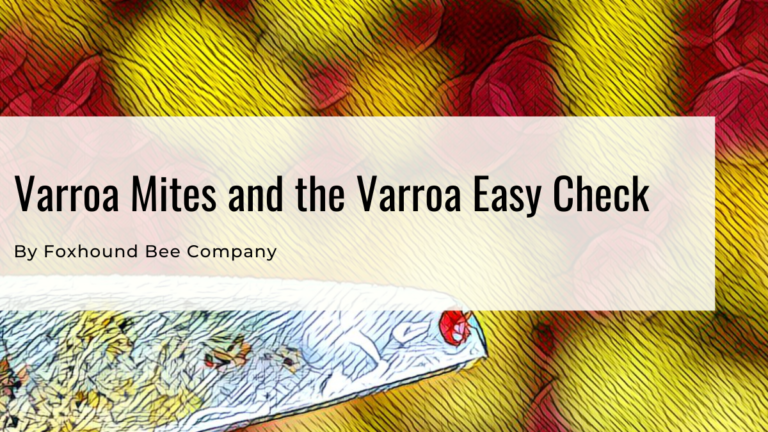
Varroa Mites and The Varroa Easy Check
Varroa Mites are insects that live in a honey bee colony and make it hard on bees to thrive. Well tell you what they are
There is an option available to beekeepers called small cell foundation that was made popular by many popular beekeepers.
The main idea behind the small cell foundation is the varroa mites that reproduce in the cells do not have as much time to reproduce in the cell as the bee spends less time developing in the same cell.
This idea has been generally disregarded as a major tool for combating the varroa mite, but it still has value. While a full sheet of foundation made of small cells (4.9mm) does not help much with varroa mites, it does allow more cells to fit onto the frame. A denser brood nest is easier to keep warm than a brood nest that is more spread out.
For this reason, we like smaller cells, but don’t find it necessary to use all small cell foundation to produce small cell bees to solve the varroa mite problem.
Large Cell Foundation
There isn’t really a specific size that you can associate with large cell foundation. Generally, it means anything on the upper end of the cell size, excluding drone comb which is about 6.4 mm. If you had to put a number to it, it would be something in the 5.4 mm to 5.6 mm range. We typically see this size associated with Mann Lakes Rite Cell.
This cell size has been the standard for many years in some foundations and would be considered oversized compared to the average cell size that worker bees naturally build.
Bush Bees has a great post on the foundation sizes available and who makes them, but it is a little outdated. The Apiarist also has some good information on cell sizes as well.
Everything In-between
The truth is that it’s a little bit of the Wild West on cell size and who makes them, and what the claims are. In truth the bee make a wide variety of sizes when making comb naturally.
We have witnessed this firsthand ourselves, and ideally, bees would be able to do this in every hive. So, in reality, the natural cell size is not a specific size as they build the size they need it when they need it.
While cell size is important, most of the manufacturers make cell sizes that are close to what bees like, and the bees will continue to draw out the comb on these regardless of the size.
Where there is a real difference is in the quality of the wax and the coverage of the wax. You will see a wide range of quality in the wax coating.
This is typically advertised as waxed, heavy wax and extra heavy wax. A nice coating of quality beeswax makes a huge difference in how the bees will use the foundation.
Poorly coated foundations or foundations coated in low-quality beeswax or fake beeswax are not drawn out well by the bees. This is generally why we only use foundations from respected dealers with a good history.
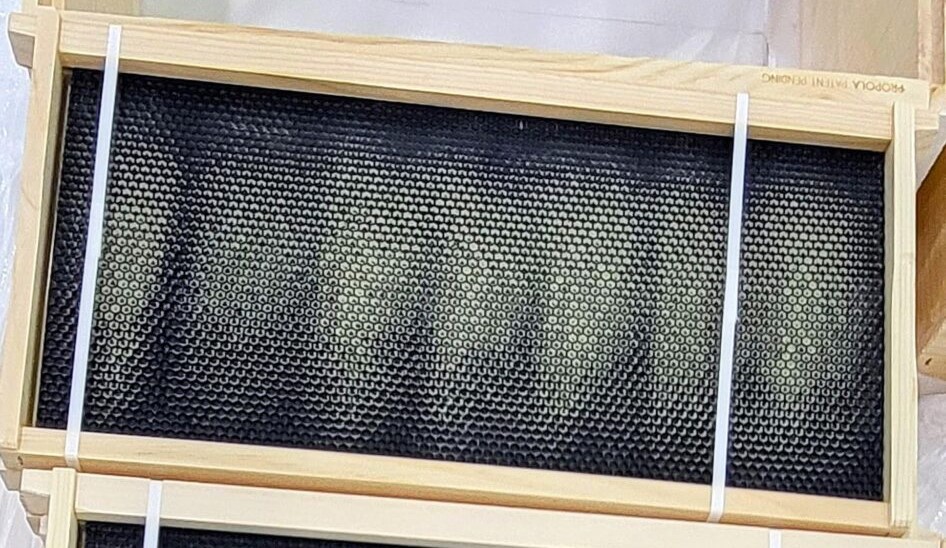


Brands Of Plastic Foundation
Acorn Gencon Plastic Foundation Cell Count
Acorn foundation is injection molded and has very clean edges and cell walls. This uniform design creates a nice product that the bees readily accept.
Medium, black, plastic foundation – 2,282 cells per side
Deep, black, plastic foundation – 3,586 cells per side
Approximate cell size: 5.2mm
This is the foundation we use and recommend at Foxhound Bee Company
Note: The bottom and top edges of the Acorn Foundation did not have cells molded into them. This is okay, as this area is covered by the wooden grooves in the top and bottom bars of the frame. So, most of the cells on the foundation are 100% usable by the bees.

Mann Lake Rite Cell Foundation Cell Count
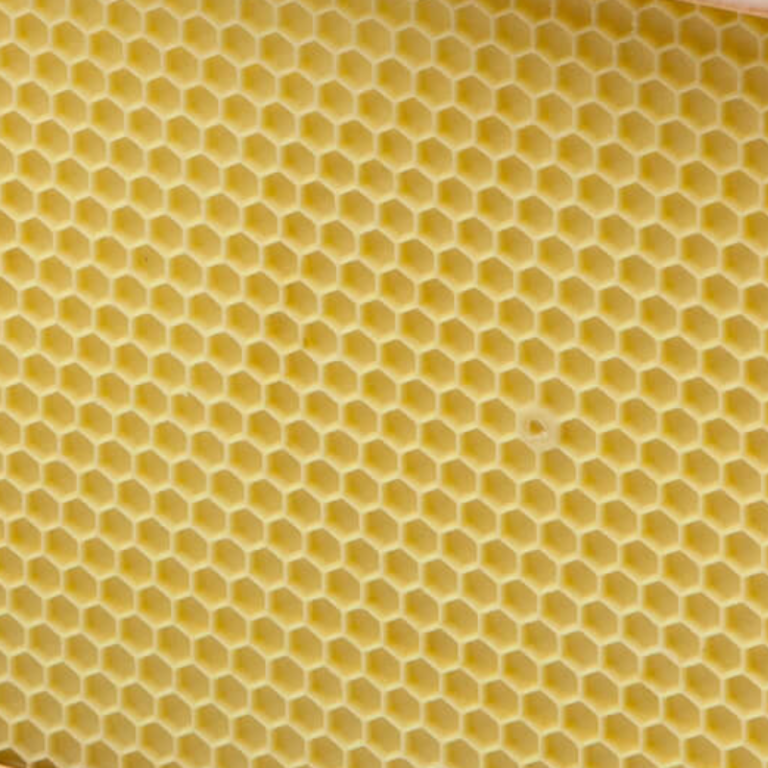
This foundation is produced by Mann Lake and is a very common foundation used in the US. We used to sell this type of foundation at Foxhound Bee Company, but we didn’t like it because of the light wax coating. They have since improved the coating of beeswax and offer a heavy wax option.
Medium, yellow, plastic, rite-cell plastic foundation – 2,133 cells per side
Deep, yellow, plastic, rite-cell foundation – 3,397 cells per side
Cell Size: 5.4mm
Note: The bottom and top edges of the Mann Lake Rite Cell Foundation did not have cells molded into them. This is ok, as this area is covered by the wooden grooves in the top and bottom bar of the frame. So, most of the cells on the foundation are 100% usable by the bees.
Mann Lake 100% Beeswax Foundation Cell Count
Medium, crimp wire 100% Wax Foundation – 2291 Cells
Deep, crimp wire 100% Wax Foundation – 3555 Cells
Note: The wax foundation is pressed with hexagons from edge to edge. The cells on the top and bottom of the foundation will be partially covered by the wood frame, slightly reducing the number of cells the bees can use. A more realistic number of usable cells is approximately 160 less than the numbers above.
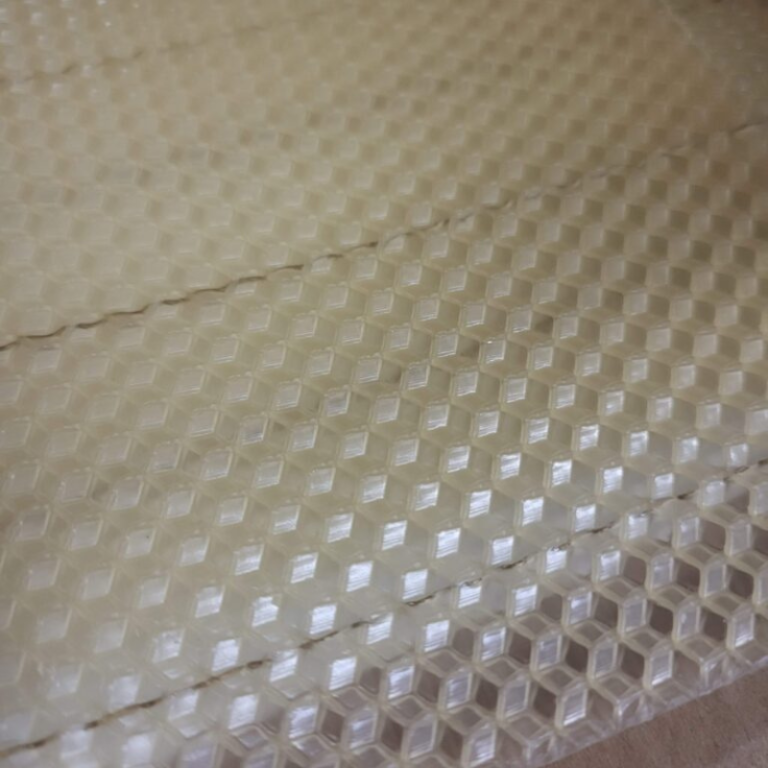
Premier / Puracell Plastic Foundation Cell Count
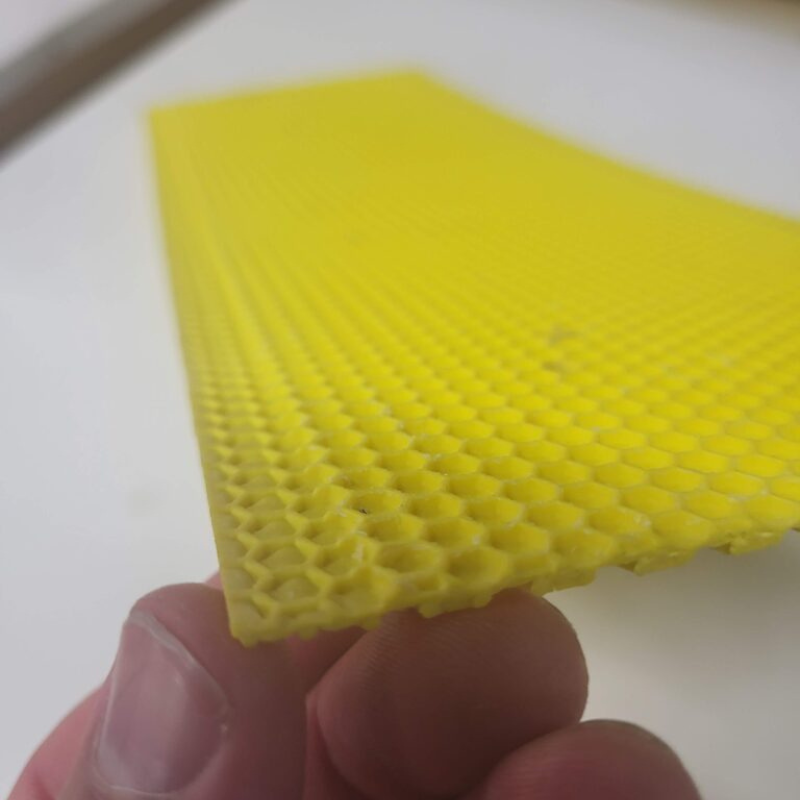
The way Premier 100% beeswax foundation is made is by taking a flat sheet of beeswax or plastic and running it through a hexagon embossed roller that presses the hexagons into the foundation. This is different than many of the other brands and is similar to an older manufacturing process used to make duragilt foundation.
Medium plastic sheets of foundation – 2400 cells per side
Deep, plastic sheets – 3680 cells per side
Cell Size: 5.2mm
Note: The Premier/Puracell foundation is a plastic foundation with hexagons pressed into the plastic. The cells cover the foundation 100% from edge to edge. This does increase the cell count per frame, but at least 1 row on the top and the bottom of the sheet is completely covered by the wooden frame. A certain amount of foundation is always covered by the frame.
When we put the Puracell foundation into a grooved top/grooved bottom frame, the wood covered 2 rows of full cells plus the partially formed cells on the edges of the foundation. This left 160-240 fewer cells available for the bees to use.
Pierco Plastic Foundation
To Be Determined, but it is likely the exact same as Acorn Foundation
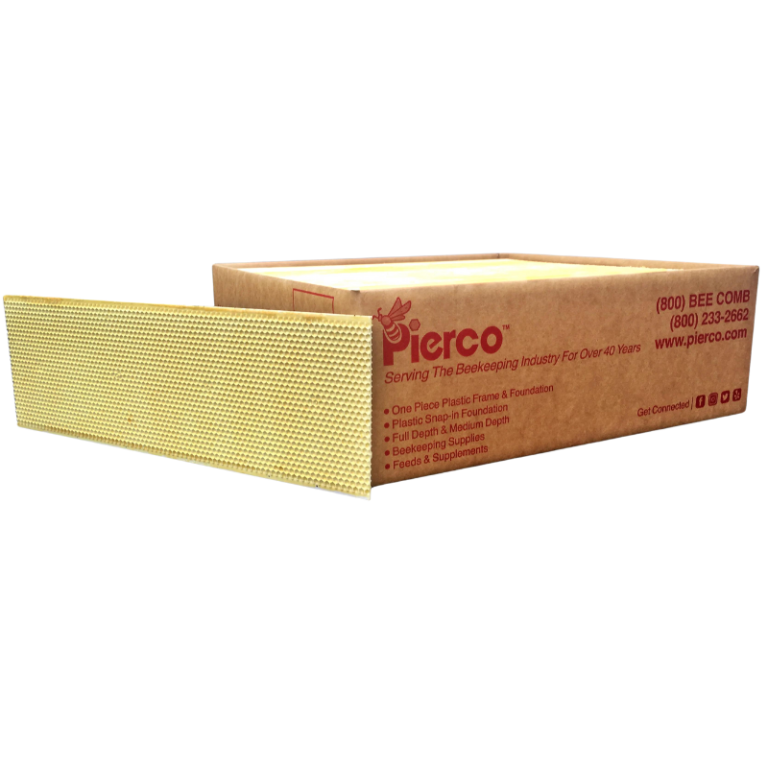
Dadant Plastic Foundation
TBD
